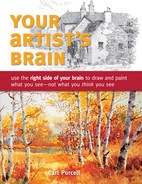CHAPTER 10
seeing SHAPES OF VALUE
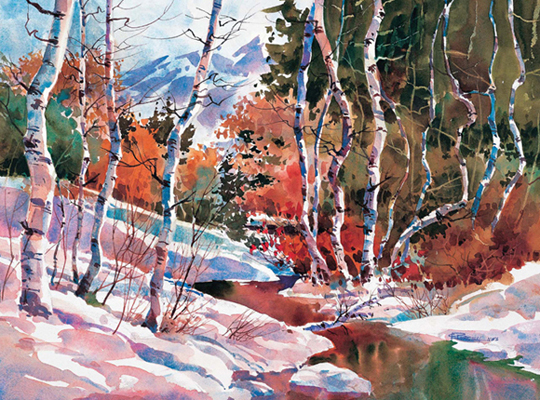
EARLY WINTER ![]() Watercolor
Watercolor ![]() 32″ × 40″ (81cm × 102cm)
32″ × 40″ (81cm × 102cm) ![]() Private collection
Private collection

In training yourself to see the four categories of shapes listed, the most powerful tool you can cultivate is the ability to simplify your subject into shapes of value. Doing this turns hundreds of items into a few simple shapes for painting. Just as squinting helps you with drawing, it will help you in painting. This may cause wrinkles at the corner of your eyes, but it eliminates detail and allows you to see big shapes of dark value more easily.
You read shapes by seeing differences in value — a critical art skill. At first your intellectual desire to separate all the items might interfere, but you will overcome this by persistently using your artist's brain. You are deprogramming your brain from what you learned as a child. Remember the coloring books you enjoyed when you were young? Each item was clearly outlined in black and you were encouraged not to go over the line. Now you have to unlearn all of that training to see shapes of value.
See dark shapes
Every time we approach a subject we are faced with the same dilemma: The intellectual brain wants us to see it as a collection of nameable items, while the artist's brain wants to see it as a group of shapes.
Squint your eyes while looking at these photos to move past the details and see the larger dark shapes. It may be helpful to view the page upside down. This further separates you from the pictorial context and allows you to focus on the shapes.

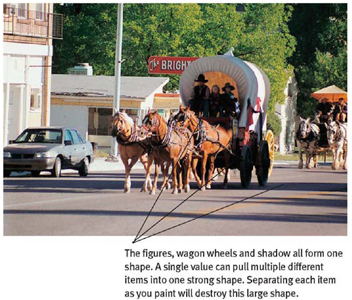
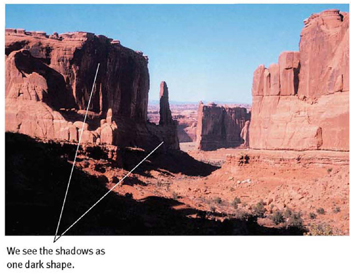

Evaluate dark shapes and adjust them for interest
Once you can see the dark shapes, you can use your artist's brain to determine what a shape needs to make it more interesting in your composition. These changes usually involve:
![]() Adding places where the shape interacts with its surrounding space shape.
Adding places where the shape interacts with its surrounding space shape.
![]() Varying the width to avoid same-width dullness.
Varying the width to avoid same-width dullness.

Stare to Avoid Details
Stare at the dark shape in this photo until the detail disappears and you see it only as a shape.

Modify the Boring Dark Shape
Varying the width of the predictable curve and creating interaction with the surrounding space shape enhances the composition.
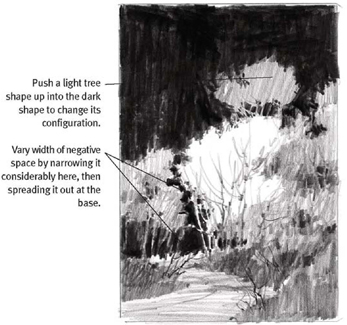
Draw the Shape and Identify Any Problems
Now draw the dark shape. When you do, you should notice one very big problem with it.

AUTUMN WALK ![]() Watercolor
Watercolor ![]() 21″ × 14″ (53cm × 36cm)
21″ × 14″ (53cm × 36cm)
Finished Painting
Most people who see this painting comment on the color, but it is really the dark shape carving out the light shape that gives it visual impact. Without changing the shape, you would only have a colorful boring shape.
See multiple shapes as one shape of similar value
Simplify numerous items by uniting them into one shape of similar value.

Reference Photo
If the intellectual brain were in charge of painting this group of people, you would outline each figure and color them in, clearly distinguishing each person. But that is not the way you see. Look at this group. Your artist's brain actually sees only a few shapes of light and dark.
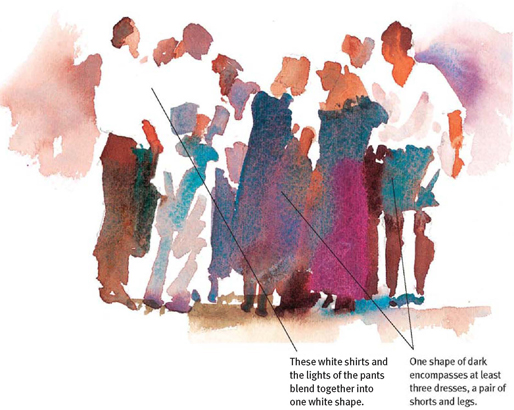
A Watercolor Sketch of Lights and Darks
This is not just a clever way to paint the group; it's a painting of the actual pattern of lights and darks that entered our brain as we saw the scene. Our eyes fill in the detail we don't see. If you get these larger value shapes right, the viewer will fill in the detail.

Practice Many Watercolor Sketches
Paint some single figures and groups of figures. Eliminate the boundaries between items and concentrate on keeping the similar values flowing together into one shape.

Reference Photo
If we started naming all the things in this photo — signs, people, buildings, and so on — we would soon get discouraged by the complexity. Instead, squint to see the larger shapes of value. These shapes are easier to draw and paint, and they are more visually accurate than the intellectual brain's version of the items would be.
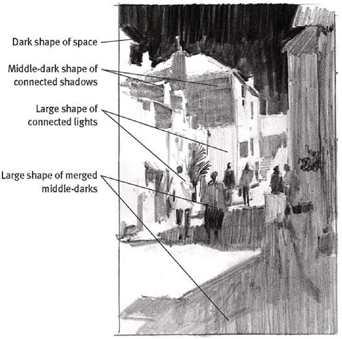
Find Big Shapes of Similar Value
If we look for the large shapes of value, we discover there are only a few. The area on the right along with the figures and the shadow on the ground become part of one huge shape of middle-dark value. The dark figures merge with the larger shape when we squint.

SHOPPING IN POLPERRO ![]() Watercolor
Watercolor ![]() 21″ × 14″ (53cm × 36cm)
21″ × 14″ (53cm × 36cm)
Finished Painting
Exercising the practice of seeing large, simple value shapes helped me to switch into shape mode for this painting. Notice the considerable range of color within the value shape. However, when you squint you will find the value of the shape does not change. This preserves the integrity of the shape. It is the value that builds a shape, not the color.
Use shapes of light to create visual paths and bridges
Artist Gerald Brommer correctly observed that, “The eye moves most easily along pathways of similar value.” If you have to jump from one place to another, you will naturally stop first and plan your jump. Your eye will do the same. If no bridge is provided, it will stop, then jump. Keep the viewer's eye moving until it gets to the center of interest.
Shapes of light have the same ability as dark shapes to connect areas of your composition and provide a visual path for the viewer. Provide a bridge from one shape of light to the next to create whole shapes of light value. And remember this: A good light shape without a dark shape to go with it is no more effective than a flashlight at noon in the Sahara.
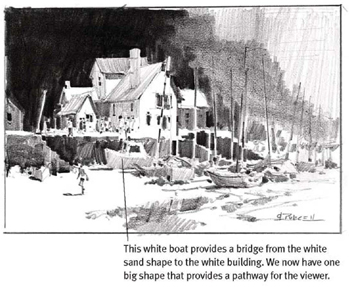

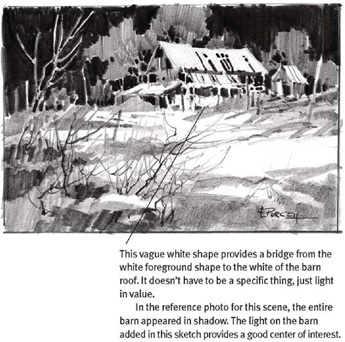
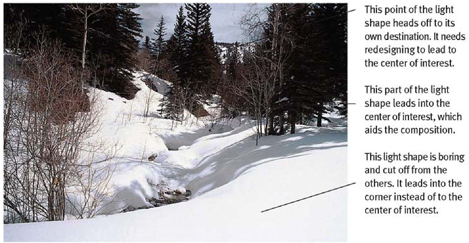
Reference Photo
In this case, there is too much of the light value and it is divided into two separate shapes. The light shapes should be interesting and lead the viewer's eye to the center of interest.

SHADOW PATTERNS ![]() Watercolor
Watercolor ![]() 14″ × 21″ (36cm × 53cm)
14″ × 21″ (36cm × 53cm)
Finished Painting
The large tree shape was broken up among the light shapes to enhance their interest and lead the viewer's eye into the center of interest. I expanded some darker values to the ends of the format to diversify the foreground light shapes. The stream also breaks up the foreground and provides a bridge to the center of interest.
Seek Good Values, Not Great Subjects

If you look for interesting light or dark shapes instead of looking for interesting subjects, you will be on your way to creating stronger paintings.
